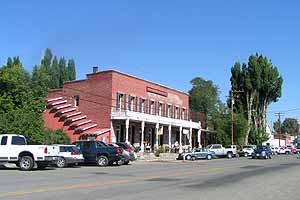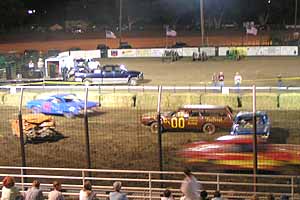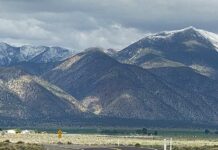What They’re saying About Us The LA Times Discovers Pyramid Lake. |
| Sign Up for our NevadaGram here. |
Last time’s piece on Ghost Towns prompted lots of positive response, so I’ll stay on the topic with a visit to Aurora.

It had been 60 years since I last walked the streets of Aurora. In that distant time there was sagebrush growing in the old dirt streets lined by big brick buildings with their windows broken out. The buildings were empty, and the city was deserted, except for my great-grandfather and me. As we walked up Pine Street, he pointed out the businesses that had thrived there in the early years of the 20th century. We gazed through the dusty glass at the entrance to the Esmeralda Hotel, built as the County Court House but turned to commercial use when Hawthorne took the County seat in 1883. He told me about a shooting that had taken place here, and showed me where he’d dived for cover, and where the shotgun pellets had pocked the door and window frames at the entrance.

Founded in 1860, a year after the discovery of the Comstock Lode, Aurora’s mines were rich enough to spawn a city built of brick. Both Nevada and California created counties Esmeralda and Mono respectively) with Aurora as their seat. So until the boundary line was drawn in 1864, Aurora’s citizens could choose which state they wished to acknowledge. “And so it was that on the second day of September 1863,” Stewart writes, “residents of Aurora trooped to the Armory Hal;l and cast votes for Esmeralda County officials; then to the Police Station to vote for a full slate of Mono County officials.”
Life was hard and hectic in the four years the mines were in high production, but by 1864 they were beginning to play out, and by 1870 times were slow. Once the second-largest city in the Nevada Territory, Aurora was dying away, and if it hadn’t been the seat of Esmeralda County, it would have happened even quicker.

Then Hawthorne grabbed the county seat and Aurora began to die in earnest. When the Post Office closed in 1897 Aurora was dead. In 1904 my great-grandfather Harry Gorham started working with Jim Cain of Bodie to bring it back to life again. They acquired the mines, and they bought the structures from owners who could be found. By 1905 the town was breathing again, and by 1906 it was in full production. It was smaller than it was at its height, just a few hundred people, but still busy and prosperous at its core. The mines produced for ten years more but by 1919 they had slowed and then stopped altogether.
Mining resumed in the 1980s and is still being conducted underground with modern equipment. It is productive to a depth unattainable with pick and shovel work in sparse ore.

We saw it in the late spring of 1946, and by late summer the big brick city was mostly gone, the great buildings knocked down for their bricks, which were loaded onto flatbed trucks, hauled to San Pedro California and made into factory chimneys. The locally made bricks were good quality, but the lime-and-sand mortar with which they were laid up makes a poor bond and degrades badly over time. Brick scavengers were able to push the brick walls down with poles, dust off the crude mortar, and re-use the bricks.

Now, 60 years later, only traces remain. Pine Street is two ruts through the sagebrush and the only structures are a small dugout cabin and a dilapidated mine building a quarter mile away. But by a major stroke of luck, our tour guide is Bob Stewart, who wrote the book on Aurora. “Aurora, Nevada’s Ghost City of the Dawn” is full of fascination for anyone whose interests include Nevada history. For the benefit of his students on this day — Mike Makley, author of the William Sharon biography “The Infamous King of the Comstock”, McAvoy Layne, who impersonates Mark Twain on stage, screen and the Tahoe Queen paddlewheeler, my son Chris and me (Bob’s wife Phyl has earned graduate standing in Auroraology) — he points across the sagebrush to where the Court House once stood, and over there the school was located, and the Del Monte mine was up there.

And up past Spring Street was Bob Howland’s cabin, where Sam Clemens bunked for a while during his Aurora spring of 1862.

The cabin is gone, with just a few sticks and shards lying in the brush, but to McAvoy these few bits of debris were like pieces of the True Cross. It was from this very spot that Sam Clemens had walked to Virginia City in July, 1862, to take a reporter’s job on the Territorial Enterprise and there assume the nom de plume Mark Twain.
During his Aurora adventure he had partnered with Cal Higbie, to whom he dedicated “Roughing It”. He and Higbie had prospected the nearby country, navigated Mono Lake and had located some rich ground adjacent to the Wide West Mine on Last Chance Hill. They had ten days to work their claim, but Higbie went seeking a cement mine to the south, and Sam went north to help care for Capt. John Nye, Governor Nye’s brother, who was lying ill at Nine Mile Ranch.

Each thought the other was doing the work, and thus the claim was lost. As McAvoy wrote in his Pine Nuts column in the North Tahoe Bonanza, “Had Sam left the Nine Mile Ranch a day earlier and worked the mine they had just claimed, we might never have met Huckleberry Finn.” Or even read “Roughing It” for that matter.
After his fortune faded away, he went back to work as a miner with his partner Higbie: “We climbed far up on the mountainside and went to work on a little rubbishy claim of ours that had a shaft on it eight feet deep. Higbie descended into it and worked bravely with his pick until he had loosened up a deal of rock and dirt and then I went down with a long-handled shovel (the most awkward invention yet contrived by man) to throw it out.
“You must brace the shovel forward with the side of your knee till it is full, and then with a skillful toss, throw it backward over your left shoulder. I made the toss and landed the mess just on the edge of the shaft and it all came back on my head and down the back of my neck. I never said a word, but climbed out and walked home. I inwardly resolved that I would starve before I would make a target of myself and shoot rubbish at it with a long-handled shovel.”

Phyl Stewart produced the finest luncheon to be served in Aurora in more than 80 years, and we spent another dusty hour in the Pinon-shaded cemetery which is the old city’s single surviving landmark.
We also traveled north, through Fernley, Wadsworth and Gerlach across the California state line to Cedarville for the Modoc County Fair.
Cedarville is at the foot of the mighty Warner Mountains and is the principal community within the Great Basin’s northwestern rim. Much of this section of eastern California was once claimed by Nevada and embraced within Lake, and then Roop County. Cedarville was still called Deep Creek when it was a part of this short-lived Nevada province, but I hereby claim it for Nevada anyhow, as it is a delightful place: pretty as a postcard, well provisioned with food and drink (yes, you can get a latte), and provided by a benign providence with an excellent bookstore.
And their Fair is a dreamy mix of nostalgia, hilarity and cowboys.




The Fair was almost without thrill rides this year when the operator called at the last minute to cancel his appearance on account of high fuel prices. A flurry of phone calls provided a replacement, but it was a close call. It’s hard to pick a favorite moment from the many, but maybe it was in the baking competition, where the pies and cakes were displayed: there was only one little sliver left of the pie that won Best of Show.
Quick notes from beyond the mountains:

The Cantaloupe Festival returns to the Fallon Fairgrounds September 1 – 4. Ya gotta go this year! Not just for the favorite activities like Cantaloupe bowling, cantaloupe eating and (ta-da!) Cantaloupe Chunkin’, but for the hilarious Swan Brothers Two Man Circus starring Topsy the dog. “People have been chunkin punkins for a long time,” Fallon’s Tourism Director Rick Gray told the press. “Eventually we would like to be the world championship Cantaloupe chunkin’ contest.”
Fallon’s cantaloupes became famous in the 1920s when local farmers supplied gourmet restaurants all around the country with the scrumptious Hearts O’ Gold cantaloupes. One of the 10 best Nevada celebrations, not counting Roop County. . . . Lots of news from Virginia City: The Virginia & Truckee Railroad made an inaugural journey from the Gold Hill depot to the end of the tracks, which is now about halfway around American Flat.

The V&T was once known as “the crookedest railroad in the world”, a tribute to its twisty tracks and its management practices. . . . Virginia City’s cemeteries are coming alive for three weekends in September as “Voices from the Past” will be presented each Saturday and Sunday from September 2 through September 17. Visitors are given a tour of the Silver Terrace cemeteries on the north end of town, and as they reach certain graves, monuments and memorials, actors portraying the departed appear to discuss their lives and deaths on the 19th century Comstock Lode. It’s a fascinating way to learn about the daily life on the Lode during the bonanza days and their aftermath

. . .And while you’re there you can now get today’s New York Times at the RV Park on the north end of town. But come early as they only get three copies. Unless the plane is late, then they don’t get any . . . The Hoye House Bed & Breakfast in Wellington is being restored to its original 19th century grandeur by new owners Mike and Kealoha Garcia. They will re-open this celebrated hostelry when improvements are completed. They have also acquired the next-door property where the Wellington Mercantile stood for more than a century before a devastating fire a few years ago. The Mercantile was famous for the variety of its goods: you could walk through the front doors and find whatever you needed, from a galvanized tub to a fresh-baked pie. The Garcias plan to rebuild it, and when the Hoye House and the Mercantile are both re-invigorated and open, Wellington will be back on the map . . .

I am embarrassed that last time I forgot to mention the biggest event of the year between Luning and Coaldale Junction: The Mina Centennial Celebration.
Stanley Paher says the Mina townsite was surveyed in August, 1905, and the Post Office opened in September of that year, but why quibble about details? Anyway it seems like only yesterday that the Nevada & California Railway established its terminus here to connect with the narrow gauge Tonopah & Goldfield. It’s hard to believe today, but until World War II and the rapid expansion of the Naval Ammunition Depot, Mina, with two trains a day to and from San Francisco, was bigger and more cosmopolitan than Hawthorne. The Centennial celebration was a lively event with two bands playing into the night and three Sheriff’s cars cruising the streets . . .

On September 14-17 eight of the top men’s and women’s professional beach volleyball teams will compete for the title of AVP Best of the Beach in the final event of the 2006 AVP Crocs Tour at the MontBleu Resort Casino at Lake Tahoe’s south shore. The double-elimination tournament will be televised on FOX Sports Net from the new 4,000-seat Sports Pavilion where the tennis courts used to be.
Overheard in the Caboose Lounge at the Ramada Express in Laughlin: “I’m all right wearing the Christian disguise, but I just don’t have it in me to be a real Christian. For that you have to be ready to face the lions and I don’t think I could do that.”
Happy Highways,















